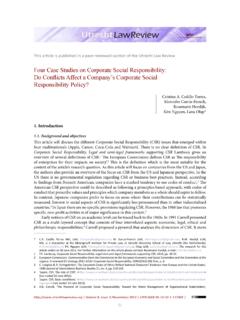Transcription of Three dimensions of organizational interoperability
1 Three dimensions of organizational interoperability Insights from recent studies for improving interoperability frame-works interoperability (IOP) is considered a critical success factor to forge ahead in the online provi-sion of public services. interoperability frameworks shall give guidance to Herbert Kubicek practitioners what to consider and to do in order to enable seamless interaction with other public authorities and clients. The well known European interoperability Framework (EIF) and many others are designed as multi- Ralf Cimander layer models, distinguishing between technical, semantic and organizational IOP. For achieving technical IOP there are acknowledged standards; for semantic IOP recog- nized concepts and methods are available.
2 However, Institute for aspects and characteristics of organizational IOP, although Informationmanagement considered to be an important success factor for Bremen (ifib). eGovernment projects, are much more heterogeneous and do not provide similar guidance. Keywords This paper suggests that it will be useful to separate this E-Government, eGovernment, heterogeneous collection of organizational issues into Three organizational interoperability , dimensions . In line with the assignment of standards and Governance, IT-Governance, protocols to the technical and semantic layer, an additional Integration of Information layer, presently called organizational IOP, should be Systems, Centralization, confined to standards and concepts dealing with the Standardization, EIF, IOP, linkage of business processes and be called business interoperability frameworks.
3 Process IOP. All other organizational aspects should be conceived as cross-cutting dimensions , as they refer to elements on all layers. These items shall allow the support of the Relevant characteristics of more than 70 good practice decisions that had to be taken cases have been collected within a Study of IOP for the by public authorities in order European Commission. Based on these indicators, an to provide for and guarantee empirical taxonomy of settings for achieving IOP at present interoperation and interoperability . is developed within an ongoing research project. The proposed classification is presented here in order to invite comments by the IOP community and at the same time is recommended for the discussion about the new draft of 1.
4 The EIF , issued in July 2008 . 1. The EIF will take the form of an official Commission position with the publication of a Communication from the Commission to the Council and to the Parliament early 2009. European Journal of ePractice 1. N 6 January 2009 ISSN: 1988-625X. 1 Defining the subject: integration and/or interoperability There is wide agreement in administrative practice and research that the use of ICT will only lead to savings and improvements if business processes are reorganized in order to allow for a seamless exchange of data between all agencies involved. In many public services, several back-offices are involved in the service- supply-chain. The data processing systems in the back-offices of these agencies have to be merged or linked up in a way to allow for a smooth online service provision across organizational boundaries.
5 However there are legacy systems in these back-offices that do not have the aspired interfaces and are difficult to change because they are linked with other systems and fulfil the local requirements of the respective agency quite well. Reorganization of back-offices cannot start from scratch. There is a need for developing a strategy which may provide a compromise between keeping local systems and still allowing for better data interchange. In a Study for the European Commission on Back-office Reorganization, about 30 Good Practice Cases have been analyzed and Three strategies have been identified. The two basic strategies for coordination, which have been distinguished in organization theory for decades (March & Simon 1958, Kieser & Kubicek 1993), are either centralization of tasks or standardization of processes.
6 As a third intermediate strategy, clearing houses have been identified (Millard et. al. 2004, Kubicek, Millard & Westholm 2007). In this context, centralization of tasks also means a centralization of data and processing functions, which formerly have been fulfilled separately in different agencies. It requires the physical merging of data from different IT-systems and is also called (data) integration. In the Back-office Reorganization Study it turned out that high savings could be achieved by public services that have realized full or almost full integration of back- offices via centralization. However, as centralization of tasks of formerly separate agencies means changes of authority and jurisdiction, this only happened when there was strong political pressure because of obvious inefficiencies, delays and backlogs.
7 An alternative option is the standardization of processes. Electronic Data interchange becomes possible if different agencies strictly follow the same procedure and use the same data formats. In the cases of linking IT. systems in different agencies in an interorganizational information system, this does not necessarily mean that internal processes, data formats and processing functions have to be standardized, but only the interfaces at the boundaries of each local system and the content and format of the data to be exchanged. Instead of integrating the separate systems into a new one, they can be kept running and only be adapted in order to provide for their interoperation via import and export interfaces. Therefore, we may speak of interoperability via standardization.
8 Scholl & Klischewski (2007) suggest distinguishing between interoperability (IOP), as the ability to allow for data exchange, and interoperation , as the practical achievement. In principle, interoperation could be achieved by direct multilateral data exchange according to the same standards by all agencies involved. However, in practice, very often intermediaries are involved, providing certain support such as directory or data conversion services. Of course, all participating agencies could run their own directories with the addresses of all partners. But obviously the cost for updating is lower if this is done only once for all participating units via a central directory. Following the terminology in the banking industry, such intermediaries have been named clearing houses in the Back-office Study.
9 Contrary to the centralization by data integration, where primary tasks and responsibilities for e-services are centralized, the primary tasks and responsibilities remain unchanged and only secondary, supportive functions are centralized by outsourcing them to one or more service providers. To sum up, efficient electronic public services depending on the cooperation of two or more agencies can either be achieved by centralization of tasks and integration of data or through achieving interoperation by standardization of interfaces and data formats, frequently realized with the help of intermediate agencies called clearing houses providing limited supporting secondary services for achieving interoperation. This means that IOP is one of at least two different strategies to enable high quality and highly efficient eGovernment services across organizational boundaries, which comes on the agenda when centralization of tasks is legally not possible, politically not feasible or not the best option because of other risks.
10 This basic distinction shall be illustrated by two examples from a study on IOP for the European Commission within the MODINIS program (Tambouris et. al. 2007), where the authors also were involved in. In Austria and in Germany, citizens have to register in the local community where they live. When moving to another local European Journal of ePractice 2. N 6 January 2009 ISSN: 1988-625X. community, they have to deregister in their old community and register in the new one. With the introduction of electronic citizens' registers this did not change for some time. Each local community had ordered their own system. In Germany there are about 5,400 local citizens registers operated on at least 17 different software products.







